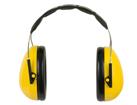Health and Safety
Taking care with materials, equipment and work procedures and dealing with hazards.
Personal protective equipment
Personal protective equipment (PPE) is used to minimise the exposure to hazards (but is not a solution for controlling hazards by elimination or isolation).
On this page:
- uses for personal protective equipment
- types of personal protective equipment
- selecting PPE
- Responsibility for PPE.
Uses for personal protective equipment
Personal protection in the workplace may be used against:
- chemicals – risk of inhalation, skin exposure and eye splash
- high temperatures – causing burns
- UV – exposure to weather
- airborne pollutants – dust, solvents and vapours
- radiation
- infection – bacteria, fungi
- physical injuries – cuts, falls, being struck by falling objects
- equipment use – power tools, plant and machinery
- electrical faults – power tool use, cables
- noise generally
- falls or slips when working at height
- extremely cold conditions
Types of personal protective equipment
- Eyes – safety glasses, goggles, face shields.
- Hearing – ear plugs, ear muffs.
- Respiratory – masks, respirators, cartridge filters.
- Head – hard hat.
- Body – overalls, safety harness, high-visibility clothing, gloves.
- Foot – steel-capped boots/shoes.
- Safety at heights – harnesses (installed anchors or restraining cables), roof edge barriers.
- Visibility – hi-visibility vests, jackets.
- Extreme cold – specialised thermal and weatherproof clothing
Selecting PPE
When selecting appropriate clothing or equipment for a task:
- talk to experts, i.e. those who use the clothing or equipment
- ensure clothing or equipment carries a standards mark
- ensure that clothing or equipment fits and looks ok (or it will not be used).
Responsibility for PPE
Under the Health and Safety at Work Act:
- Employers must provide protective equipment and ensure that the clothing or equipment is worn.
- Employees must wear/use the protective equipment.
- Employers cannot pay extra money instead of providing the equipment.
- Employers cannot require employees to provide their own equipment as a condition of employment.
Updated: 04 August 2016


